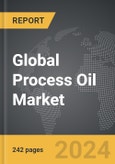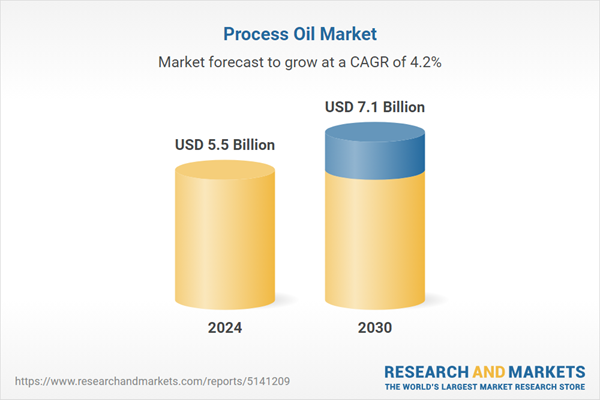The global market for Process Oil was valued at US$5.5 Billion in 2024 and is projected to reach US$7.1 Billion by 2030, growing at a CAGR of 4.2% from 2024 to 2030. This comprehensive report provides an in-depth analysis of market trends, drivers, and forecasts, helping you make informed business decisions. The report includes the most recent global tariff developments and what they mean for your business.
Segments: Application (Tire & Rubber, Polymer, Personal Care, Textile, Other Applications); Type (Aromatic, Paraffinic, Naphthenic, Non-carcinogenic).
Geographic Regions/Countries: World; United States; Canada; Japan; China; Europe (France; Germany; Italy; United Kingdom; Spain; Russia; and Rest of Europe); Asia-Pacific (Australia; India; South Korea; and Rest of Asia-Pacific); Latin America (Argentina; Brazil; Mexico; and Rest of Latin America); Middle East (Iran; Israel; Saudi Arabia; United Arab Emirates; and Rest of Middle East); and Africa.
The analysts continuously track trade developments worldwide, drawing insights from leading global economists and over 200 industry and policy institutions, including think tanks, trade organizations, and national economic advisory bodies. This intelligence is integrated into forecasting models to provide timely, data-driven analysis of emerging risks and opportunities.
Global Process Oil Market - Key Trends and Drivers Summarized
Process Oil: A Critical Component in Industrial Manufacturing and Processing
Process oil is a type of petroleum-based oil used as a raw material or processing aid in various industrial applications. It plays a crucial role in the manufacturing of products such as rubber, plastics, textiles, and chemicals, where it acts as a lubricant, plasticizer, or carrier fluid. Process oils are available in different grades, including paraffinic, naphthenic, and aromatic, each offering specific properties that make them suitable for different industrial uses. In the rubber industry, process oil is used to improve the flexibility, durability, and workability of rubber compounds, making it an essential ingredient in the production of tires, hoses, and other rubber products. In the plastics industry, process oil is used as a plasticizer to enhance the flexibility and processing characteristics of plastic resins. By serving as a vital component in various industrial processes, process oil contributes to the quality and performance of a wide range of products.How Are Technological Advancements Improving the Quality and Efficiency of Process Oils?
Technological advancements have significantly improved the quality, performance, and environmental sustainability of process oils, making them more effective and versatile in industrial applications. The development of high-purity process oils with low aromatic content has reduced the environmental impact and improved the safety of process oils, making them more suitable for use in sensitive applications such as food-grade products and medical devices. Innovations in refining techniques have enhanced the stability and performance of process oils, ensuring consistent quality and reducing the risk of product contamination. Additionally, the introduction of synthetic process oils has expanded the range of applications for these products, offering superior performance in extreme temperatures and harsh conditions. These technological improvements are driving the adoption of process oils across various industries, helping manufacturers achieve better product quality, efficiency, and environmental compliance.What Are the Key Applications and Benefits of Process Oils?
Process oils are used in a variety of industrial applications, offering numerous benefits that enhance product quality, manufacturing efficiency, and environmental sustainability. In the rubber industry, process oils are essential for producing high-quality rubber compounds that meet the performance requirements of tires, automotive parts, and industrial products. In the plastics industry, process oils improve the flexibility, durability, and workability of plastic resins, enabling the production of a wide range of plastic products with specific properties. The chemical industry relies on process oils as solvents and carriers in the production of various chemical formulations, ensuring consistent quality and stability. The primary benefits of process oils include improved material properties, enhanced processing efficiency, and reduced environmental impact. By providing a reliable and versatile component in industrial manufacturing processes, process oils help businesses achieve higher levels of productivity, quality, and sustainability in their operations.What Factors Are Driving the Growth in the Process Oil Market?
The growth in the process oil market is driven by several factors. The increasing demand for high-performance rubber and plastic products in industries such as automotive, construction, and consumer goods is a significant driver, as process oils are essential for achieving the desired material properties in these products. Technological advancements in refining and formulation are also propelling market growth, as these innovations improve the quality, performance, and environmental sustainability of process oils. The rising focus on environmental compliance and sustainability is further boosting demand, as businesses seek to reduce their environmental footprint and meet regulatory requirements. Additionally, the expansion of the global manufacturing sector and the growing adoption of advanced manufacturing techniques are contributing to market growth, as these trends increase the need for high-quality process oils. The increasing investment in research and development, coupled with the growing availability of specialized process oils for specific applications, is also supporting the growth of the process oil market. These factors, combined with continuous innovation in oil refining and formulation, are driving the sustained growth of the process oil market.Report Scope
The report analyzes the Process Oil market, presented in terms of units. The analysis covers the key segments and geographic regions outlined below.Segments: Application (Tire & Rubber, Polymer, Personal Care, Textile, Other Applications); Type (Aromatic, Paraffinic, Naphthenic, Non-carcinogenic).
Geographic Regions/Countries: World; United States; Canada; Japan; China; Europe (France; Germany; Italy; United Kingdom; Spain; Russia; and Rest of Europe); Asia-Pacific (Australia; India; South Korea; and Rest of Asia-Pacific); Latin America (Argentina; Brazil; Mexico; and Rest of Latin America); Middle East (Iran; Israel; Saudi Arabia; United Arab Emirates; and Rest of Middle East); and Africa.
Key Insights:
- Market Growth: Understand the significant growth trajectory of the Aromatic segment, which is expected to reach US$1.3 Billion by 2030 with a CAGR of a 3.8%. The Paraffinic segment is also set to grow at 4.3% CAGR over the analysis period.
- Regional Analysis: Gain insights into the U.S. market, valued at $1.6 Billion in 2024, and China, forecasted to grow at an impressive 6.4% CAGR to reach $1.3 Billion by 2030. Discover growth trends in other key regions, including Japan, Canada, Germany, and the Asia-Pacific.
Why You Should Buy This Report:
- Detailed Market Analysis: Access a thorough analysis of the Global Process Oil Market, covering all major geographic regions and market segments.
- Competitive Insights: Get an overview of the competitive landscape, including the market presence of major players across different geographies.
- Future Trends and Drivers: Understand the key trends and drivers shaping the future of the Global Process Oil Market.
- Actionable Insights: Benefit from actionable insights that can help you identify new revenue opportunities and make strategic business decisions.
Key Questions Answered:
- How is the Global Process Oil Market expected to evolve by 2030?
- What are the main drivers and restraints affecting the market?
- Which market segments will grow the most over the forecast period?
- How will market shares for different regions and segments change by 2030?
- Who are the leading players in the market, and what are their prospects?
Report Features:
- Comprehensive Market Data: Independent analysis of annual sales and market forecasts in US$ Million from 2024 to 2030.
- In-Depth Regional Analysis: Detailed insights into key markets, including the U.S., China, Japan, Canada, Europe, Asia-Pacific, Latin America, Middle East, and Africa.
- Company Profiles: Coverage of players such as Apar Industries Ltd., Avista Oil AG, Behran Oil Company, Calumet Specialty Products Partners LP, Chevron Corporation and more.
- Complimentary Updates: Receive free report updates for one year to keep you informed of the latest market developments.
Some of the 38 companies featured in this Process Oil market report include:
- Apar Industries Ltd.
- Avista Oil AG
- Behran Oil Company
- Calumet Specialty Products Partners LP
- Chevron Corporation
- Cross Oil
- Ergon North & South America
- ExxonMobil Chemical Company
- H&R GmbH & Co. KGaA
- Hindustan Petroleum Corporation Limited
- HollyFrontier Refining & Marketing LLC
- Iranol Company
- Mark Speciality India Pvt. Ltd.
- Nynas AB
- Orgkhim Biochemical Holding
- Panama Petrochem Ltd.
- Paramo A.S.
- Petronas Lubricants Belgium NV
- Phillips 66 Company
- Raj Petro Specialities Pvt. Ltd.
- Repsol SA
- Royal Dutch Shell PLC
- Sunoco Lubricants
- Tirupati Balaji Riders Oil Co. Private Limited
- Total SA
- Vintrol Lubes Pvt. Ltd.
- Witmans Industries Pvt. Ltd.
Tariff Impact Analysis: Key Insights for 2025
Global tariff negotiations across 180+ countries are reshaping supply chains, costs, and competitiveness. This report reflects the latest developments as of April 2025 and incorporates forward-looking insights into the market outlook.The analysts continuously track trade developments worldwide, drawing insights from leading global economists and over 200 industry and policy institutions, including think tanks, trade organizations, and national economic advisory bodies. This intelligence is integrated into forecasting models to provide timely, data-driven analysis of emerging risks and opportunities.
What’s Included in This Edition:
- Tariff-adjusted market forecasts by region and segment
- Analysis of cost and supply chain implications by sourcing and trade exposure
- Strategic insights into geographic shifts
Buyers receive a free July 2025 update with:
- Finalized tariff impacts and new trade agreement effects
- Updated projections reflecting global sourcing and cost shifts
- Expanded country-specific coverage across the industry
Table of Contents
I. METHODOLOGYII. EXECUTIVE SUMMARY2. FOCUS ON SELECT PLAYERSIII. MARKET ANALYSISSOUTH KOREAREST OF ASIA-PACIFICARGENTINABRAZILMEXICOREST OF LATIN AMERICAIRANISRAELSAUDI ARABIAUNITED ARAB EMIRATESREST OF MIDDLE EASTIV. COMPETITION
1. MARKET OVERVIEW
3. MARKET TRENDS & DRIVERS
4. GLOBAL MARKET PERSPECTIVE
UNITED STATES
CANADA
JAPAN
CHINA
EUROPE
FRANCE
GERMANY
ITALY
UNITED KINGDOM
SPAIN
RUSSIA
REST OF EUROPE
ASIA-PACIFIC
AUSTRALIA
INDIA
LATIN AMERICA
MIDDLE EAST
AFRICA
Companies Mentioned (Partial List)
A selection of companies mentioned in this report includes, but is not limited to:
- Apar Industries Ltd.
- Avista Oil AG
- Behran Oil Company
- Calumet Specialty Products Partners LP
- Chevron Corporation
- Cross Oil
- Ergon North & South America
- ExxonMobil Chemical Company
- H&R GmbH & Co. KGaA
- Hindustan Petroleum Corporation Limited
- HollyFrontier Refining & Marketing LLC
- Iranol Company
- Mark Speciality India Pvt. Ltd.
- Nynas AB
- Orgkhim Biochemical Holding
- Panama Petrochem Ltd.
- Paramo A.S.
- Petronas Lubricants Belgium NV
- Phillips 66 Company
- Raj Petro Specialities Pvt. Ltd.
- Repsol SA
- Royal Dutch Shell PLC
- Sunoco Lubricants
- Tirupati Balaji Riders Oil Co. Private Limited
- Total SA
- Vintrol Lubes Pvt. Ltd.
- Witmans Industries Pvt. Ltd.
Table Information
| Report Attribute | Details |
|---|---|
| No. of Pages | 242 |
| Published | April 2025 |
| Forecast Period | 2024 - 2030 |
| Estimated Market Value ( USD | $ 5.5 Billion |
| Forecasted Market Value ( USD | $ 7.1 Billion |
| Compound Annual Growth Rate | 4.2% |
| Regions Covered | Global |









